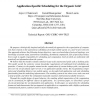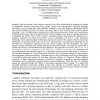154 search results - page 4 / 31 » Where Does Ubiquitous Computing Lead the Organization |
PPSN
2000
Springer
13 years 11 months ago
2000
Springer
Abstract. There are evolutionary trajectories in two different but related spaces, design space and niche space. Coevolution occurs in parallel trajectories in both spaces, with co...
CLUSTER
2004
IEEE
13 years 11 months ago
2004
IEEE
We propose a biologically inspired and fully-decentralized approach to the organization of computation that is based on the autonomous scheduling of strongly mobile agents on a pe...
COMPGEOM
2009
ACM
13 years 5 months ago
2009
ACM
Computed tomography(CT), especially since the introduction of helical CT, provides excellent visualization of the internal organs of the body. As a result, CT is used routinely in...
IPTPS
2003
Springer
14 years 25 days ago
2003
Springer
We are building Coral, a peer-to-peer content distribution system. Coral creates self-organizing clusters of nodes that fetch information from each other to avoid communicating wi...
TIS
2010
13 years 2 months ago
2010
: Since the invention of the electronic computer in the 1940s, technological development has resulted in dramatically increased processing power, storage capacity and communication...


